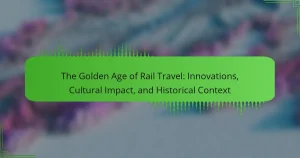High-speed rail offers significant benefits in transportation efficiency and reduced carbon footprints. This article explores the evolution of high-speed rail since the 1960s, examines key technologies that enable rapid travel, and compares global systems like Japan’s Shinkansen and China’s extensive network. It also addresses the challenges faced in implementing these projects and highlights future trends focused on sustainability and connectivity.

How has high-speed rail evolved over the decades?
High-speed rail has significantly evolved since its inception in the 1960s, driven by technological advancements and increased demand for efficient transportation. Initially, trains like the Shinkansen in Japan set the standard with speeds over 200 km/h. Over the decades, innovations such as magnetic levitation and improved aerodynamics have pushed speeds beyond 600 km/h. Countries like France and China have developed extensive networks, showcasing unique attributes in design and operational efficiency. As a result, high-speed rail has become a vital component of modern infrastructure, promoting economic growth and reducing carbon footprints.
What were the key milestones in high-speed rail development?
Key milestones in high-speed rail development include the launch of Japan’s Shinkansen in 1964, which set the standard for speed and efficiency. France’s TGV followed in 1981, achieving speeds over 300 km/h. The introduction of the Eurostar in 1994 connected London to Paris and Brussels, enhancing international travel. China’s high-speed rail network began in 2008, rapidly expanding to over 38,000 kilometers, making it the largest in the world. The ongoing technological advancements focus on safety, energy efficiency, and passenger comfort, reflecting a commitment to sustainable transportation solutions.
Which countries pioneered high-speed rail technology?
Japan and France pioneered high-speed rail technology, launching their systems in the 1960s. Japan introduced the Shinkansen in 1964, achieving speeds over 200 km/h. France followed with the TGV in 1981, reaching speeds of 300 km/h. These innovations set the foundation for high-speed rail networks worldwide. Other countries, like Germany and Spain, later adopted and expanded upon these technologies.
How do cultural attitudes influence high-speed rail adoption?
Cultural attitudes significantly influence high-speed rail adoption by shaping public perception and acceptance. Societies valuing environmental sustainability tend to support high-speed rail projects, seeing them as eco-friendly alternatives to cars and planes. In contrast, cultures that prioritize individual car ownership may resist such initiatives, viewing them as threats to personal freedom. Additionally, national pride can enhance support for domestic high-speed rail systems, as seen in countries like Japan and France. Public trust in government and investment in infrastructure also plays a crucial role in adoption rates.
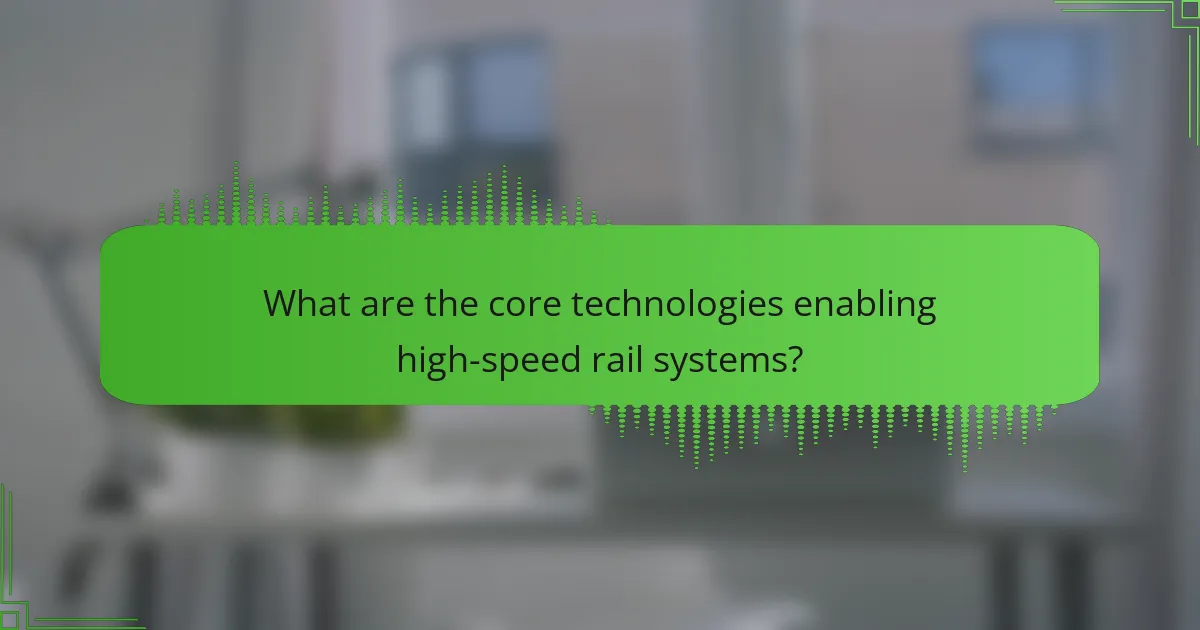
What are the core technologies enabling high-speed rail systems?
High-speed rail systems rely on advanced technologies such as magnetic levitation, aerodynamic train designs, and sophisticated signaling systems. These technologies enable trains to achieve speeds exceeding 300 km/h while ensuring safety and efficiency. Magnetic levitation eliminates friction, allowing for smoother and faster travel. Aerodynamic designs reduce air resistance, enhancing speed and energy efficiency. Advanced signaling systems manage train operations, ensuring precise scheduling and safety. Together, these technologies represent the evolution of rail transport, setting benchmarks for future developments.
How do train design and aerodynamics impact performance?
Train design and aerodynamics significantly enhance high-speed rail performance by reducing drag and improving stability. Streamlined shapes minimize air resistance, which is crucial for achieving high speeds. Advanced materials and engineering techniques further optimize weight and strength, allowing for faster acceleration and braking. For instance, the Shinkansen in Japan employs aerodynamic nose designs that reduce shock waves, enhancing passenger comfort and energy efficiency.
What role does track infrastructure play in high-speed rail efficiency?
Track infrastructure is crucial for high-speed rail efficiency, as it directly impacts speed, safety, and reliability. High-speed rail systems require specialized tracks designed to handle higher speeds with minimal friction and vibration. The alignment and construction of these tracks ensure smooth transitions and reduce wear on trains.
Additionally, track infrastructure includes features like dedicated corridors, which prevent interference from slower trains. This separation enhances punctuality and reduces travel times. Advanced signaling systems integrated with the track also optimize train movements, further improving efficiency.
In summary, well-designed track infrastructure is essential for maximizing the performance and safety of high-speed rail systems globally.
Which signaling and control technologies enhance safety and speed?
Advanced signaling and control technologies significantly enhance safety and speed in high-speed rail systems. These include positive train control, automated train protection, and real-time monitoring systems. Positive train control prevents collisions and derailments by automatically controlling train speeds based on track conditions. Automated train protection systems ensure compliance with speed limits and signal indications, further reducing human error. Real-time monitoring systems collect data on train performance and infrastructure, allowing for proactive maintenance and timely responses to potential issues. Together, these technologies create a safer and more efficient high-speed rail network.
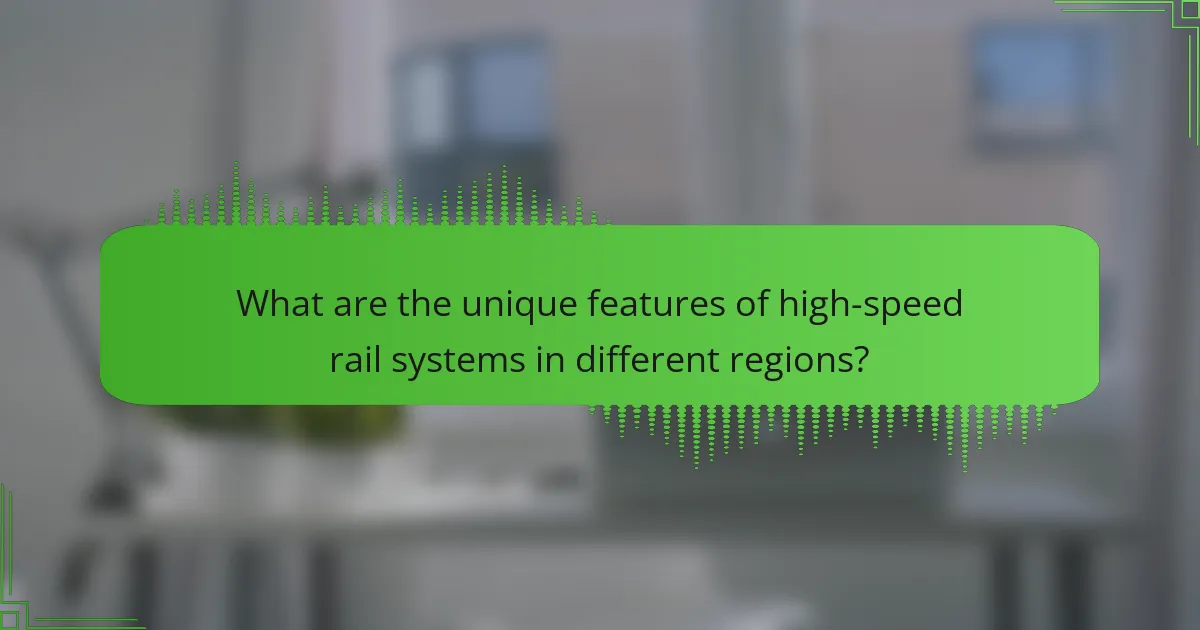
What are the unique features of high-speed rail systems in different regions?
High-speed rail systems exhibit unique features across different regions, shaped by local needs and technologies. For example, Japan’s Shinkansen emphasizes punctuality and safety, with trains operating at speeds up to 320 km/h. In contrast, France’s TGV focuses on extensive connectivity, linking major cities with a network that reaches speeds of 300 km/h. China leads in scale, featuring the world’s longest high-speed rail network, operating trains at 350 km/h. Spain’s AVE showcases innovative designs, integrating high-speed travel with regional services. Each system reflects regional priorities, from speed to connectivity and safety.
How do European high-speed trains differ from those in Asia?
European high-speed trains prioritize passenger comfort and efficient integration with local transport, while Asian trains focus on speed and advanced technology. European systems, like France’s TGV, emphasize scenic routes and accessibility. In contrast, Japan’s Shinkansen showcases cutting-edge engineering with speeds exceeding 300 km/h. Europe typically operates on dedicated tracks, while Asia often combines high-speed with conventional rail, enhancing overall connectivity.
What innovations are found in North American high-speed rail projects?
North American high-speed rail projects feature innovations such as advanced train control systems, energy-efficient technologies, and integrated ticketing solutions. These innovations enhance safety, reduce travel times, and improve passenger experience. For instance, the use of magnetic levitation technology significantly decreases friction, allowing trains to reach higher speeds. Additionally, sustainable energy sources are being integrated, contributing to reduced carbon emissions.
Which sustainability practices are being adopted globally?
High-speed rail systems are increasingly adopting sustainability practices globally. These include energy-efficient technologies, renewable energy integration, and reduced carbon emissions.
Countries like Japan and France lead in using advanced rail technologies that minimize energy consumption. For instance, Japan’s Shinkansen utilizes regenerative braking systems, which recover energy during deceleration.
Additionally, many high-speed rail networks are transitioning to renewable energy sources. For example, Spain’s AVE trains are powered by 100% renewable energy, significantly lowering their carbon footprint.
Global comparisons show that high-speed rail systems not only enhance connectivity but also contribute to sustainable transportation goals, reducing reliance on fossil fuels.
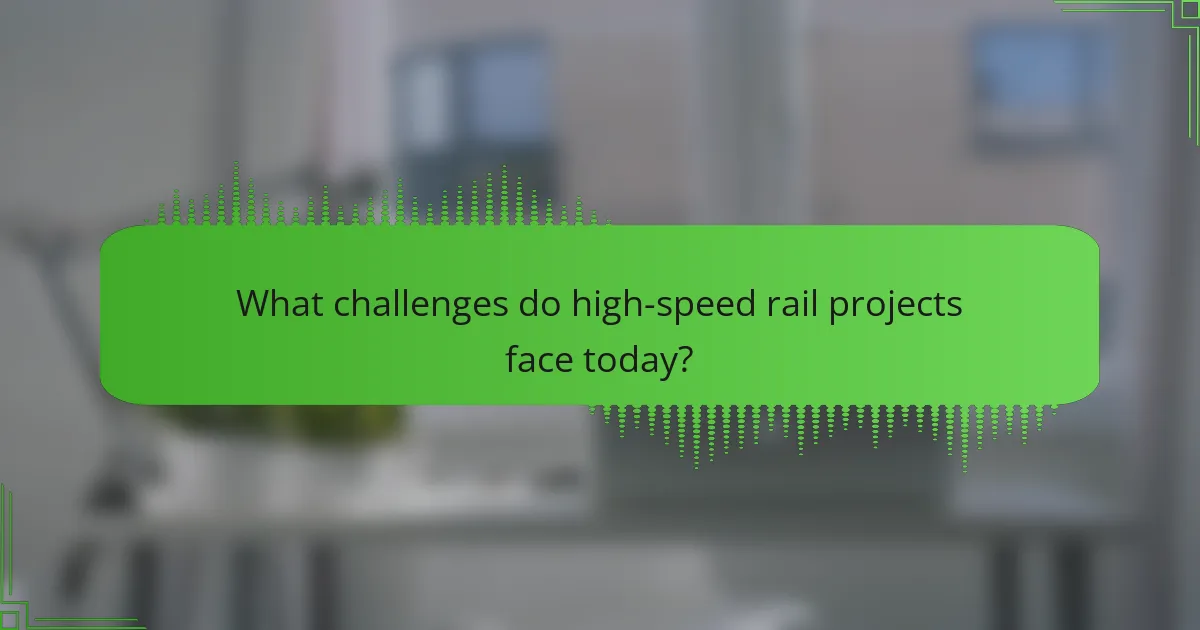
What challenges do high-speed rail projects face today?
High-speed rail projects face numerous challenges today, including funding, regulatory hurdles, and public acceptance. Securing adequate investment remains a significant obstacle, as these projects often require substantial upfront capital. Regulatory processes can delay timelines, complicating project execution. Additionally, gaining public support is crucial, as communities may resist construction due to perceived disruptions or environmental concerns. These factors collectively hinder the successful implementation of high-speed rail systems globally.
How do funding and investment impact high-speed rail development?
Funding and investment significantly influence high-speed rail development by determining project feasibility and scope. Adequate financial backing allows for advanced technologies and infrastructure improvements. For instance, government funding can accelerate project timelines, while private investment may enhance innovation. Countries like Japan and France exemplify successful funding strategies that have led to extensive high-speed rail networks. In contrast, insufficient investment can stall projects, limiting service areas and technology adoption.
What are the common technical and operational hurdles?
High-speed rail faces common technical and operational hurdles that impact its implementation and efficiency. Key challenges include high initial capital costs, complex engineering requirements, land acquisition issues, and regulatory hurdles. Additionally, integrating high-speed rail with existing transportation networks poses operational difficulties. These factors can delay projects and increase overall expenses.
How does public perception affect high-speed rail initiatives?
Public perception significantly influences high-speed rail initiatives by shaping public support and funding. Positive perceptions can lead to increased investment and policy backing, while negative views may result in project delays or cancellations. Community engagement and effective communication about benefits, such as reduced travel times and environmental impacts, are crucial for fostering a favorable public opinion. For instance, successful high-speed rail systems in countries like Japan and France have benefited from strong public backing, demonstrating the importance of addressing public concerns and highlighting advantages.
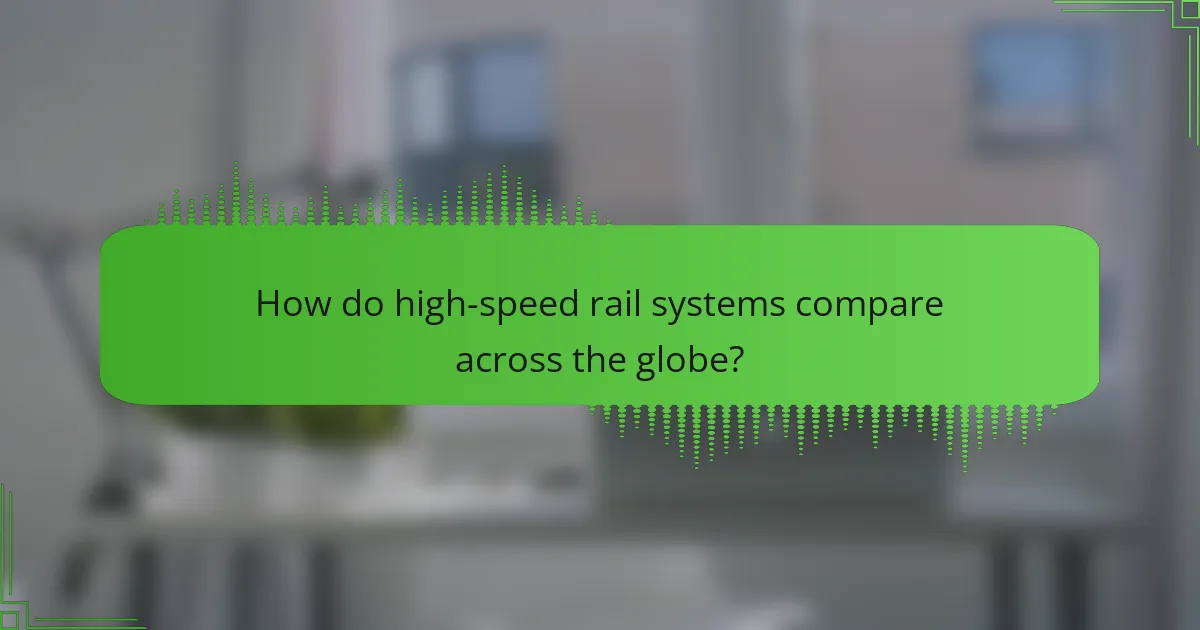
How do high-speed rail systems compare across the globe?
High-speed rail systems vary significantly across the globe in terms of technology, speed, and efficiency. Countries like Japan and France lead in speed and ridership, while others are expanding their networks.
| Country | Top Speed | Network Length | Year Introduced | Notable Technology |
|—————|———–|—————-|——————|————————–|
| Japan | 320 km/h | 3,000 km | 1964 | Shinkansen |
| France | 320 km/h | 2,600 km | 1981 | TGV |
| China | 350 km/h | 38,000 km | 2007 | CRH |
| Spain | 310 km/h | 3,200 km | 1992 | AVE |
| Germany | 300 km/h | 1,500 km | 1991 | ICE |
| Italy | 300 km/h | 1,000 km | 2008 | Frecciarossa |
These systems reflect advancements in rail technology and their impact on transportation efficiency.
What metrics are used to evaluate high-speed rail performance?
High-speed rail performance is evaluated using metrics such as speed, frequency, punctuality, capacity, and energy efficiency. These metrics help assess operational effectiveness and passenger satisfaction.
| Metric | Description |
|——————|—————————————–|
| Speed | Maximum operational speed of trains |
| Frequency | Number of services per time period |
| Punctuality | On-time performance percentage |
| Capacity | Passenger capacity per train |
| Energy Efficiency | Energy consumption per passenger-km |
Which countries have the fastest high-speed rail networks?
China, Japan, and France have the fastest high-speed rail networks globally. China’s network, with speeds up to 350 km/h, is the largest, while Japan’s Shinkansen operates at 320 km/h. France’s TGV follows closely with speeds reaching 300 km/h. Other notable countries include Spain and Germany, which also feature advanced high-speed rail systems.
How does ridership and service frequency vary internationally?
High-speed rail ridership and service frequency vary significantly across countries due to factors like infrastructure investment and cultural preferences. For instance, Japan’s Shinkansen boasts high frequency and ridership, with over 400 million annual passengers. In contrast, the United States has limited high-speed rail, resulting in lower ridership numbers. European nations like France and Spain also show strong ridership, supported by extensive networks and frequent services. These variations highlight how investment levels and national priorities shape high-speed rail systems globally.

What are the future trends shaping high-speed rail?
Future trends in high-speed rail focus on sustainability, technological advancements, and increased connectivity. Innovations like maglev technology and improved energy efficiency will enhance speed and reduce environmental impact. Countries are investing in extensive networks to support economic growth and reduce congestion. As a result, high-speed rail will become a crucial component of modern transportation systems globally.
How is technology evolving to improve high-speed rail systems?
Technology is evolving rapidly to enhance high-speed rail systems through advancements in infrastructure, energy efficiency, and passenger experience. Innovations like magnetic levitation and advanced signaling systems increase speed and safety. Countries like Japan and France lead in implementing these technologies, showcasing unique attributes such as Japan’s Shinkansen trains achieving speeds over 300 km/h. Additionally, rare attributes like energy recovery systems are being integrated to improve sustainability. As a result, high-speed rail continues to expand, offering efficient travel options globally.
What role will high-speed rail play in sustainable transportation?
High-speed rail will significantly enhance sustainable transportation by reducing carbon emissions and traffic congestion. It offers an efficient alternative to road and air travel, promoting environmental benefits. High-speed trains can travel at speeds exceeding 300 km/h, cutting travel times and encouraging public transit use. Countries like Japan and France have successfully integrated high-speed rail, showcasing its potential to transform transportation systems globally.
Which upcoming projects are set to redefine high-speed rail?
Several upcoming high-speed rail projects aim to redefine travel efficiency and connectivity. Notable examples include the California High-Speed Rail, which targets speeds of 220 mph, and the Japan Maglev project, expected to reach 310 mph.
The European Union’s Rail Baltica project will enhance connectivity across the Baltic states, while China’s new lines will extend its existing network, further reducing travel times. These projects incorporate advanced technologies such as magnetic levitation and improved train control systems, showcasing a commitment to sustainable transportation solutions.
As these initiatives progress, they promise to transform regional economies and set new standards in high-speed rail travel.
What best practices can be adopted from successful high-speed rail systems?
Successful high-speed rail systems adopt several best practices that enhance efficiency and ridership. These include integrated transportation planning, advanced signaling technologies, and a focus on customer experience.
Integrated transportation planning ensures seamless connections with other modes of transport, increasing accessibility. Advanced signaling technologies, such as European Train Control System (ETCS), improve safety and operational efficiency. A focus on customer experience, including amenities and punctuality, fosters loyalty and encourages higher ridership.
Additionally, public-private partnerships can provide funding and innovation, while consistent maintenance schedules ensure reliability. By implementing these strategies, high-speed rail systems can thrive and expand their reach effectively.

